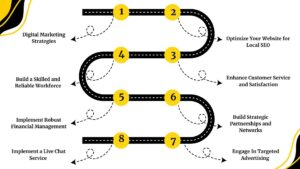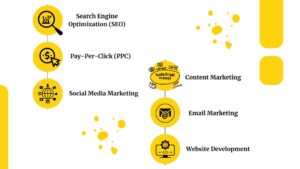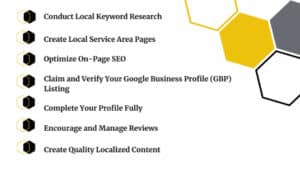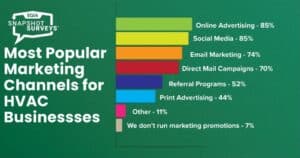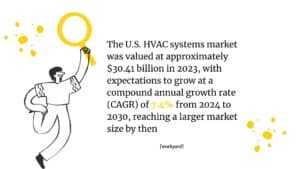Want your HVAC business to go viral?
Start by not ghosting your customers like a cold draft. In HVAC, “cool” isn’t just your product; it should be your brand.
Fun fact: Most HVAC companies are one email list away from doubling revenue!

Either way, if you are in the business of ducts and thermostats, it’s time to move beyond just fixing broken ACs. And start building a rock-solid HVAC business plan!
So, whether you are a seasoned tech or just stepping into the world of HVAC (Heating, Ventilation, and Air Conditioning), it’s time to blend your hands-on skills with digital smarts.
Speaking of digital smarts, MonsterClaw is getting outstanding results for the HVAC industry for the last few years.
At A Glance: The 8 Steps Of Growing A Heating And Air Conditioning Business
| 1. Digital Marketing Strategies | 5. Implement Robust Financial Management |
| 2. Optimize Your Website for Local SEO | 6. Build Strategic Partnerships and Networks |
| 3. Enhance Customer Service and Satisfaction | 7. Engage In Targeted Advertising |
| 4. Build a Skilled and Reliable Workforce | 8. Implement a Live Chat Service |
Ready to supercharge your HVAC business?
Let MonsterClaw turn up the heat with expert SEO, killer content, high-converting websites, and affiliate services that bring the leads to you!
Grow A Heating And Air Conditioning Business: In 8 Steps
Growing a heating and air conditioning business isn’t about knowing your way around compressors and coils! It’s about keeping up with HVAC industry trends!
By understanding what customers want, you can make your brand stand out. The key to success is connecting with the right HVAC customers at the right time.
For this, it takes strategy, savvy, and a bit of smart marketing swagger!
Let’s explore the steps in 8 ways!
1. Digital Marketing Strategies To Grow Your HVAC Business
Digital marketing is essential for growing an HVAC company as it raises online presence and produces service-quality leads.
Study says,
82% of HVAC businesses believe that digital marketing is essential to their development. It emphasizes its critical function in generating leads and growing the organization. (Source: Statista)
- Relatable Read: 7 Common Digital Marketing Mistakes and How to Fix Them
Search Engine Optimization (SEO)
Improving your HVAC website’s organic and local search rankings makes it easier for potential clients to find your services.
It’s also about who shows up first on Google. That’s where HVAC SEO comes into play. It helps your company rise above the competition!
Pay-Per-Click (PPC)
By focusing on local markets, targeted PPC campaigns on platforms such as Google Ads can generate leads and conversions right away.
Social Media Marketing
Creating interesting material on sites like Facebook, Instagram, and LinkedIn can
- Increase brand awareness
- Build connections with current clients
- Draw in new ones
Relatable Read: 5 Social Media Strategies That Can Improve SEO Results
Content Marketing
Creating e-books, case studies, videos, and blogs informs clients about your services and positions you as an expert in the HVAC industry.
Email Marketing
Sending out incentives, maintenance reminders, and useful advice on a regular basis to your clients promotes loyalty and repeat business.
Website Development
Having a mobile-friendly, easily navigable website increases conversions and trustworthiness. The website must contain contact details, service listings, and testimonials.
- Relatable Read: 6 Trendy & Useful eCommerce Website Design Tips
2. Optimize Your Website for Local SEO
This is where the real magic happens. You are telling search engines, ‘Hey, we’re here, and we serve this specific area!
Check out 👇
Professional SEO Services – MonsterClaw
Research says,
HVAC SEO brings out an estimated 678% return on investment. It provides long-term benefits. These include more exposure and organic traffic.
Conduct Local Keyword Research
Look for local keywords that your audience searches for, like ‘HVAC company near me‘ or ‘HVAC services in [City Name].’
Use these keywords in your website content, meta titles, descriptions, headers, URLs, and image alt texts.
- Relatable Read: What To Do When A Competitor Targets Your Brand Keywords
Create Local Service Area Pages
Create specialized sites. Include relevant material for each region. Highlight your experience and the benefits of your services in every service area your company serves.
Optimize On-Page SEO
Make your website load quickly. Ensure it is mobile-friendly and secure with HTTPS. Make it easy to use. To boost conversions, display call-to-action (CTA) buttons like ‘Request a Quote‘ or ‘Schedule a Repair‘ prominently.
- Relatable Read: On-Page SEO for Shopify Home, Collection, Product Pages
Claim and Verify Your Google Business Profile (GBP) Listing
To appear in the Google Map 3-Pack, you need to take action. It is prominently displayed in local search results.
Complete Your Profile Fully
Add a precise company name, address, phone number (NAP), service areas, service descriptions, business hours, website URL, images, and booking links. Update this information frequently.
Encourage and Manage Reviews
To increase trust and boost local SEO ranks, actively look for favorable Google reviews from your clients and swiftly address reviews.
Create Quality Localized Content
Keep a blog or resources section to offer practical HVAC advice, industry news, frequently asked questions, and local issues. Use local keywords to attract and engage your community.
- Relatable Read: How to Set Realistic SEO Goals for Your Enterprise Business?
3. Enhance Customer Service and Satisfaction
It is essential to have a user-friendly website that offers the information that local clients require.
A study says that after a positive experience, 81% of consumers are likely to return. However, 61% will switch after one negative encounter. [Source: FieldEdge]
Understand and Anticipate Customer Needs
HVAC companies can develop a customer-focused strategy by listening to clients, showing empathy, and anticipating their questions or issues. This creates a positive experience that builds loyalty.
Clear and Effective Communication
Provide consumers with clear and simple descriptions of HVAC services, costs, and schedules. This makes them feel valued and informed. Give frequent updates before, during, and after service. This helps build confidence and prevents misunderstandings.
Prompt Response and Timely Service
Quick reaction times are important, especially in emergencies. Consumers prefer fast visits and real-time notifications about technician arrivals. These actions improve satisfaction and decrease annoyance.
4. Build a Skilled and Reliable Workforce
Train your employees properly. They are the public face of your company.
Study says,
Heating, air conditioning, and refrigeration companies will need an average of 42,500 workers each year for the next ten years. This demand is due to growth and retirements. [Source: Heating, Air Conditioning, and Refrigeration Mechanics and Installers]
Mastering Communication and Scheduling
Spend money on thorough training courses that cover more ground than just scripts.
Train your staff on how to:
- Actively hear the wants and needs of customers.
- Explain technical knowledge understandably while communicating with clarity and empathy.
- Effectively handle appointment scheduling by providing practical choices and verifying information.
- Be professional and kind when handling difficult conversations.
Use Multiple Recruiting Channels
Advertise on HVAC-specific job boards.
For instance, social media networks (Facebook, LinkedIn), trade schools, veteran affairs departments, and online job markets to attract qualified applicants
Create Compelling Job Ads
Write clear job ads that explain the job duties, required certifications, benefits, career growth opportunities, pay range, and company culture. Use strong calls to action to encourage people to apply.
Some other ways of building a skilled and reliable workforce to grow your HVAC business are:
- Engage with trade schools and apprenticeships
- Use HVAC recruiting software
- Conduct complete assessments
- Leverage employee referrals
- Offer complete training programs
Relatable Read: What To Do When A Competitor Targets Your Brand Keywords
5. Implement Robust Financial Management
A successful HVAC company requires good financial management. You can increase profitability and handle the sector’s ups and downs by putting solid processes in place. This will also give you a clear view of your financial health.
Track Expenses Accurately and Regularly
Use programs like Excel or QuickBooks. Document each transaction carefully. This way, you can track all business income and costs in real-time.
Use Specialized HVAC and Accounting Software
Combine accounting software with HVAC-specific software to manage work orders, invoices, client information, and financial reports. For example, use QuickBooks with Payzerware or Smart Service.
Process Receipts and Invoices Promptly
Financial document input done on time prevents late penalties, interest charges, and delays to cash flow.
Involve Your Team in Budgeting and Forecasting
Collaborate with different departments to create projection models and multi-year budgets.
Consider the following factors:
- Company objectives
- Project variability
- Seasonal patterns
Monitor Financial KPIs
To assess the health of your company and make wise decisions, keep an eye on your:
- Sales income
- Gross margin
- Profit and loss
- Operational expenses
- Return on advertising
Relatable Read: HOW TO BUILD A KILLER SALES FUNNEL
6. Build Strategic Partnerships and Networks
Building strong partnerships in the industry helps you reach more people and expand your services. It also allows you to manage your finances wisely.
Study says,
Globally, roughly 2,000 strategic alliances are formed annually. This number is rising by 15% annually. It indicates how important and dependent corporate partnerships are becoming.
Participate in Local Professional Associations
Connect with contractors, manufacturers, suppliers, and service providers. Actively join HVAC trade associations and local business groups.
Work Together With Providers of Complementary Services
Work with energy efficiency specialists, electricians, plumbers, and other experts. Reach out to them to offer complete solutions and promote your services together. This will help you grow your clientele.
Attend Industry Events and Workshops
Attend conferences, workshops, and trade exhibitions. Network with colleagues. Learn about market trends. Contact potential partners and customers directly.
Leverage Online Platforms and Social Media
To network with business executives,
- Exchange material
- Look into joint marketing opportunities
- Keep up with trends
- Use LinkedIn and other professional networks
Share Knowledge
Host webinars to show your expertise. Write articles to establish credibility. Take part in forums to create lasting connections in your network.
7. Engage In Targeted Advertising
Broad advertising often feels like yelling into thin air. You need targeted advertising to get the most from your marketing investment.
Target your audience to reach people most likely interested in your products. Use data and platform tools to identify specific demographics, interests, habits, and online activities.
Study says,
Hvac companies use about 85% of marketing channels. They target customers through internet advertising like Google Ads and social media ads.
[Source: Contractor University]
Key Benefits of Targeted Advertising
- Increased ROI: You can reduce wasted ad spend and increase conversions by focusing on qualified prospects.
- Enhanced Relevance: Ads that match specific needs and interests lead to higher engagement rates.
- Personalized Customer Experience: Custom messaging helps you build a closer relationship by making your audience feel heard.
- Accurate Audience Segmentation: Platforms offer tools to segment your audience based on various parameters, enabling targeted advertising.
Strategies for Effective Targeting
- Target users based on their age, gender, location, income, and education level.
- Reach people who are interested in topics related to your products or services.
- Target customers based on their online behavior, like website visits, past purchases, and app usage.
- Expand your reach by targeting people who share traits with your current customers.
- Bring back customers who interacted with your brand but haven’t bought anything.
Relatable Read: IT Services Pricing Strategy Guideline
8. Implement a Live Chat Service
Customers expect quick help in today’s fast-paced internet world. Adding a live chat feature to your website creates a direct connection.
You can respond to questions, offer assistance, and guide potential clients in real-time.
Advantages of Integrating Live Chat
- Improved Customer Satisfaction: Prompt and effective responses make customers happy and increase loyalty.
- Increased Conversion Rates: Addressing issues quickly and providing information removes obstacles in the buying process.
- Important Customer Insights: Chat logs reveal common queries and customer problems.
- Increased Sales Opportunities: Proactively inviting visitors to chat can encourage them to make a purchase.
- Cost-effective Assistance: Live chat is more efficient than phone or email support because it can handle multiple questions at once.
Best Practices for Live Chat Implementation
- Strategic Placement: Place the chat window in a visible spot on relevant pages.
- Fast Reactions: Ensure agents respond quickly to questions.
- Personalized Interactions: Train agents to be kind, knowledgeable, and understanding.
- Proactive Engagement: Add chat invitations on key pages like product and checkout pages.
- Smooth Integration: Ensure the chat platform connects easily with your website and other support tools.
Want To Grow Your HVAC Business? – Contact MonsterClaw Today!
With MonsterClaw, you are not just blowing hot air! You are tapping into a powerhouse of affiliate marketing, digital strategy, and lead generation.
So, if you are serious about turning cold calls into hot leads, it’s time to unleash the monster in your marketing.
- Let MonsterClaw handle the hustle so you can use your time on strategies!
FAQ: Growing A Heating and Air Conditioning Business
Is it wise to invest in HVAC?
Yes, it can be a wise decision to invest in HVAC to improve comfort and health, and reduce energy costs in the long run.
Why is there a demand for HVAC?
HVAC is in high demand as it maintains comfortable and healthy indoor environments for both residential and commercial spaces.
What is the HVAC industry’s profit margin?
Although the profit margin in the HVAC sector may vary greatly, it typically falls between 5% and 20%.
How can an HVAC company advertise?
An HVAC business can promote using several platforms, including social media and websites like Google Ads. In addition to more traditional techniques like direct mail and word-of-mouth recommendations.
In HVAC, what generates the highest revenue?
The highest-paying HVAC jobs are Thermal Engineer, HVAC Project Manager, HVAC Sales Representative, and many more.

